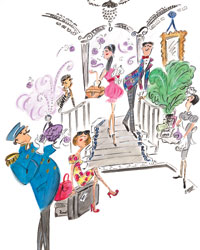One afternoon in 2006, Eva Ziegler, a marketing executive at Le Méridien hotels, walked into an unusual perfume store in Manhattan called Le Labo. The store, which designs custom fragrances, belonged to two young Frenchmen, Edouard Roschi and Fabrice Penot, and Penot began talking to Ziegler about a scent he’d always had in his head. “The idea was to do a scent of old books in a wonderful library, old paper, leather, wooden shelves,” says Penot. Ziegler was shopping for a smell for Le Méridien, and she asked Le Labo to make it for her.
Since Le Méridien was founded in 1972 by Air France, Penot and Roschi took a very old copy of Antoine de Saint-Exupéry’s Le Petit Prince—the author was a pilot—and had the rich smell of the book’s pages analyzed. (Capturing the scents of familiar objects is quite standard in this industry, though presumably the choice of this particular old book for the testing was more whimsical then determinative.) They used the results to create a scent, which they took to Ziegler. She decided it would be Le Méridien’s signature fragrance, its olfactory logo.
Everyone is scenting. Ritz-Carlton, Mandarin Oriental, Shangri-La, Marriott. When it comes to making an impression, a comfortable lobby and high-quality service are essential, of course, but among the more subtle cues, none is getting more attention these days than fragrance. “There is data that shows the power of scent to drive loyalty,” says Ziegler. “It brings people back to a place.” Ross Klein, president of the luxury brands group at Starwood, led the development of scent logos for W and St. Regis. W’s is called Bling. As for the St. Regis, “We like clients to feel they’re arriving at their own home, curated by Mrs. Astor, so the scent has the roses and sweet peas Mrs. Astor loved with a little bit of Mr. Astor’s tobacco.” The air in these hotels—as is often the case—is scented using candles.
At Kimpton Hotels, “we didn’t want guests to be cognizant of the smell,” says Niki Leondakis, the company’s COO. “We wanted it to subtly create a memory and evoke the Kimpton experience whenever they walk into the lobby.” Grand Hyatt and Hyatt Regency hotels use one of a handful of Hyatt scents, but each of the upscale Park Hyatts has its own individual fragrance. “All of our hotels scent the environment,” says Hyatt marketing executive Sara Kearney. “But only the Parks have signature brands. We wanted them to have a unique, individual pattern of emotional attachment. And we try to find indigenous scents.” The Mandarin Oriental, New York developed a candle for its front desk based on the hotel’s signature Mandarin Blossom Tea. “It has a very distinctive, fresh and delicious scent,” says director of communications Tammy Peters.
Eva Ziegler’s development of Le Méridien’s scent is a good illustration of the way the business works. A Viennese marketing veteran, Ziegler’s job was to transform a brand the Starwood group had bought in 2005. Le Méridien’s 120 or so hotels needed renovation—not just physically, Ziegler knew, but conceptually. She put together her creative team, and called it LM100: she had Jean-Georges Vongerichten for cuisine, a representative from Illy for coffee, the Grammy-winning producer Henri Scars Struck to curate music, and others. The Méridien properties were of mixed quality, and Ziegler was seeking to unify them, to give Méridien a clearer identity and communicate it to the hotel’s guests.
LM100 focused on turning Le Méridien hotels into creative hubs, with people from the art, architecture, cuisine, design, and fashion worlds. “We have research that says the first ten minutes of a stay sets a guest’s mind whether it is positive or not,” says Ziegler. “So how can we make that first impression special?”
When they presented the Saint-Exupéry scent, “Le Méridien absolutely loved it,” says Penot, “and at the same time they were nervous. ‘Is this guest-friendly?’ We did one small modification, bumping up the vanilla to increase the sense of comfort. And they took it.” Soon the Méridien fragrance will grace the lobbies of every hotel in the brand. “The front door is no longer a door,” says Ziegler, “it’s a transitional portal. You enter into the Méridien world via the scent.”
All the interest in scent design has spawned a small industry. The U.K.’s two-year-old Brand Sense Agency, for example, “helps brands make a deeper emotional connection with consumers by appealing to all five senses,” says CEO Simon Harrop. “Marketing has had an overreliance on vision, words and pictures, and those appeal to the rational parts of our brains. Smell, taste, and touch appeal to the emotional parts, so we’re helping brands get to first base with consumers faster.” He notes that scent branding in travel has been used since the mid-1970’s: “Singapore Airlines has a branded scent,” he says, used in all of its planes, a light sweet scent like pure steam from fresh rice. “If you’re booking a flight,” he says, “you’ll find it that much harder to go with the competition because the Singapore scent builds the brand in the limbic system.” (Yes, he’s perfectly serious: the limbic system.)












